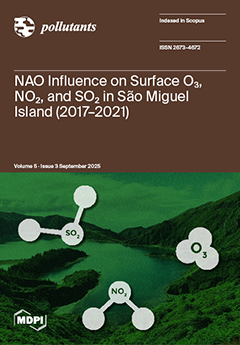Seafood contamination by heavy metals is a growing public health concern, particularly in regions like Tunisia where seafood is a major dietary component. This study assessed concentrations of cadmium (Cd), copper (Cu), lead (Pb), and zinc (Zn) in the muscle tissue of the
[...] Read more.
Seafood contamination by heavy metals is a growing public health concern, particularly in regions like Tunisia where seafood is a major dietary component. This study assessed concentrations of cadmium (Cd), copper (Cu), lead (Pb), and zinc (Zn) in the muscle tissue of the red shrimp
Parapenaeus longirostris, collected in 2023 from four coastal regions: Bizerte, Monastir, Kerkennah, and Gabes. Metal analysis was conducted using flame atomic absorption spectroscopy. This species was chosen due to its ecological and economic importance. The study sites were chosen based on their differing levels of industrial, urban, and agricultural influence, providing a representative overview of regional contamination patterns. Mean concentrations were 1.04 µg/g for Zn, 0.59 µg/g for Cu, 1.56 µg/g for Pb, and 0.21 µg/g for Cd (dry weight). Pb was the most prevalent metal across sites. Statistically significant variation was observed only for Cu (
p = 0.0334). All metal concentrations were below international safety limits set by FAO/WHO and the European Union. Compared to similar studies, the levels reported were similar or slightly lower. Human health risk was evaluated using target hazard quotient (THQ), hazard index (HI), and cancer risk (CR) values. For adults, THQ ranged from 5.44 × 10
−6 to 8.43 × 10
−4, while for children it ranged from 2.40 × 10
−5 to 3.72 × 10
−3. HI values were also well below 1, indicating negligible non-carcinogenic risk. CR values for Cd and Pb in both adults and children fell within the acceptable risk range (10
−6 to <10
−4), suggesting no significant carcinogenic concern. This study provides the first field-based dataset on metal contamination in
P. longirostris from Tunisia, contributing valuable insights for seafood safety monitoring and public health protection.
Full article





